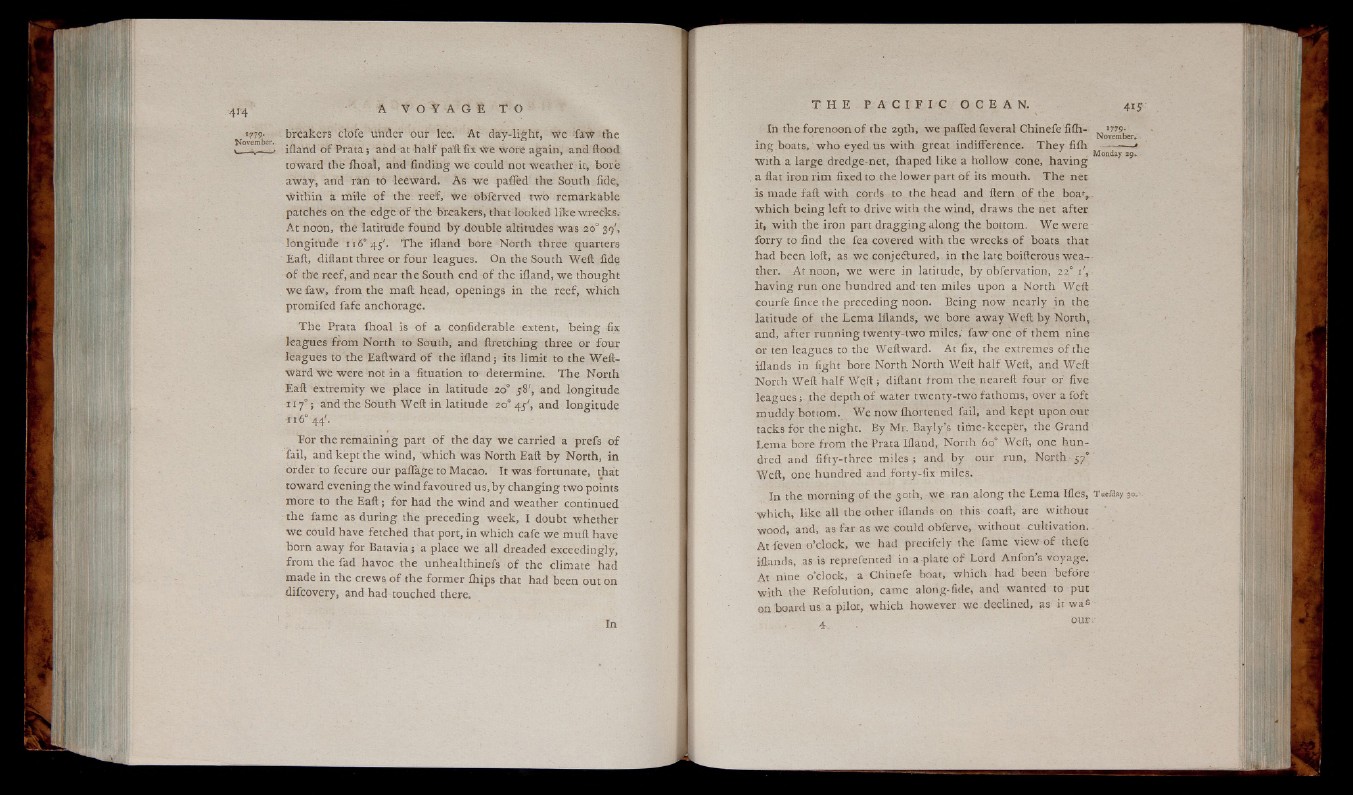
1779' breakers cloïe ütader our lee. At day-light, we faw the
> y ^ ifland o f Prata ; and at h a lf pa’ft fix # e Wore again, and flood
toward the fhôaï, and finding we conld not weather it, bore
away1, and ran to leeward. As we palled the South fide,
within a mile o f the reef, We obfêrved two remarkable
patches on the edge o f the breakers, that looked like wrecks.
At noon, the latitude found by double altitudes was 20° 39',
longitude 116° 45'. The ifland bore North three quarters
Eaft, diflant three or four leagues. On the South Weft fide
o f the reef, and near the South end o f the ifland, we thought
we faw, from the maft head, openings in the reef, which
promifed fafe anchorage.
T h e Prata Ihoal is o f a confiderable extent, being fix
leagues from North to South, and ftretching three or four
leagues to the Eaftward o f the ifland ; its limit to the Weft-
wkrd we were not in à fituation to determine. The North
Eaft extremity we place in latitude 20° 58', and longitude
117°; and the South Weft in latitude 20° 4 / , and longitude
1 16° 44'.
For the remaining part o f the day we carried a prefs o f
fail, and kept the Wind, which was North Eaft by North, in
order to fecüre our pafiage to Macao. It was fortunate, that
toward evening the wind favoured us, by changing two points
more to the Eaft ; for had the wind and weather continued
the fame as during the preceding week, I doubt whether
we could have fetched that port, in which cafe we muft have
born away for Batavia; a place we all dreaded exceedingly,
from the fad havoc the unhealthinefs o f the climate had
made in the crews o f the former ihips that had been out on
difcovery, and had touched there.
In
In the forenoon o f the 20th, we palled feveral Chinefe fifh- „ >779.
** % N o v em b e r *
in g boats, who eyed Us with great indifference. They f i i h t
, „ , , , , , . Monday 29, with a large dredge-net, lhaped like a hollow cone, having
a flat iron rim fixed to the lower part o f its mouth. The net
is made fall with cords to the head and ftern o f the boar,
which being left to drive with the wind, draws the net after
it, with the iron part dragging along the bottom. We were
forry to find the fea covered with the wrecks o f boats that
had been loft, as we conjectured, in the late boifterous weather.
At noon, we were in latitude, by obfervation, 22° i',
having run one hundred and ten miles upon a North Weft
courfe fince the preceding noon. Being now nearly in the
latitude o f the Lema Iflands, we bore away Weft by North,
and, after running twenty-two miles,' faw one o f them nine
or ten leagues to the Weftward. At fix, the extremes o f the
iflands in fight bore North North Weft h a lf Weft, and Weft
North Weft h a lf Weft ; diftant from the, neareft four or five
l e a g u e s t h e depth o f water twenty-two fathoms, over a foft
muddy bottom. We now lhortened fail, and kept upon our
tacks for the night. By Mr. Bayly’s time-keeper, the Grand
Lema bore from the Prata Ifland, North 60° Weft, one hundred
and fifty-three miles ; and by our run, North 57*'
Weft, one hundred and forty-fix miles.
In the morning o f the 30th, we ran along the Lema Ifles, Tuefday 30.'.
which, like all the other iflands on this coaft, are without
wood, and, as far as we could obferve, without cultivation.
At feven o’clock, we had precifely the fame view o f thefe
iflands, as is reprefented in a plate o f Lord Anfon’s voyage.
At nine o’clock, a Chinefe boat, which had been before
with the Refolution, came along-fide, and wanted to put
on board us a pilot, which however we declined, as it was
4 o u r